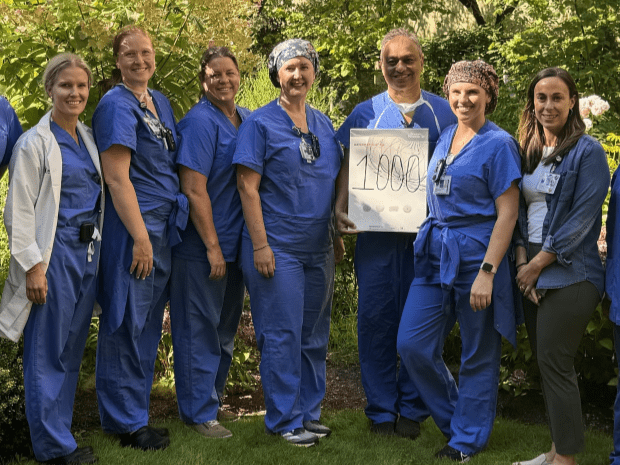Patient Stories
Legacy reaches milestone for two specialty surgeries
January 03, 2025
Home > About > News & Media > Story Center

Melissa Tufts, NP
Sarah Hilderbrand, RN
Gretchen Watson, RT
Terisha McCoy, RN
Amish Desai, MD
Jayme Mahler, RT
Crystal Jones
Lisa Bentley’s active lifestyle took a precipitous downturn in the mid-2000s. An irregular heartbeat left the Milwaukie resident tired and unable to swim, walk and garden as much as she wanted.
The medical treatment at the time called for the use of a blood thinner, but those didn’t work for Bentley and put her at risk of a stroke. Eventually she was introduced to Dr. Amish Desai, an interventional cardiologist and Director of the Structural Heart Program at Legacy Medical Group. He specializes in a procedure referred to as left atrial appendage occlusion or LAAO.
“Dr. Desai was a godsend,” Bentley said. “I’ve had zero problems since my surgery. I’m off the blood thinners and have my life back.”
Bentley was one of the earliest patients to have the LAAO procedure done at Legacy. Today, she’s one of 1,000 patients to be treated at Legacy. It’s a milestone shared with another catheter-based structural heart surgery that also started about a decade ago at the healthcare system and marks medical development, institutional coordination, and a focus on patient care. For Mayank Agrawal, MD, and a cardiac interventionist on the team, there’s one more important element.
“To me, that 1,000th patient milestone means quality,” he said. “You don’t reach 1,000 patients treated without providing quality care.”
The procedures reaching this hallmark are called the left atrial appendage occlusion or LAAO and transcatheter aortic valve replacement or TAVR.
The LAAO is performed with a small device called Watchman, that is permanently implanted into the heart to close the left atrial appendage to prevent blood clots from forming.
TAVR is like placing a stent in an artery. The TAVR approach delivers a fully collapsible replacement valve to the site of a diseased valve through a catheter. Once the new valve is expanded, it pushes the old valve leaflets out of the way, and the tissue in the replacement valve takes over the job of regulating blood flow.
Back in 2005, Amish Desai, MD, was an interventional cardiologist in Seattle involved with the Watchman clinical trial. The Federal Drug Administration approved the device in 2015 about the same time Amish came to Legacy.
He was recruited to help build the cardiology program at Legacy Medical Group. Legacy leaders had decided to integrate the cardiovascular service line into its hospitals creating a more comprehensive and advanced model of care delivery compared to the existing private practice model.
“It was an amazing time,” Dr. Desai said. “I was the fourth or fifth person brought onto the team and by the third year we had quadrupled in size.”
The Watchman procedure had also gone from an unknown in Oregon to a proven procedure. When Bentley met Dr. Desai, her life revolved around trips to the lab to get her blood count monitored. The blood thinner drugs offered no relief. Bentley thought she was out of options until she met Dr. Desai.
“He was caring and thoughtful and explained everything he was going to do” she said. “He gave me the background on the research and the testing. His staff was also outstanding. They were so well trained and knew just what to do.”
People who need the TAVR surgery report a decline in their daily activities much like what Bentley experienced. In their case, the wear and tear on the heart valve is the problem. These people are often older and unable to undergo open heart surgery to fix the issue. Without treatment, a person might face congestive heart failure. The catheter based TAVR provides a much less invasive option and has become the standard of care for aortic valve replacement in most older patients.
Dr. Desai and Dr. Agrawal are quick to note Legacy reached this milestone because of the talented people who comprise the heart team. It’s not just the structural interventionist but also the cardiac surgeons, nursing staff, catheterization lab technologists, cardiac anesthesiologists, and many others.
“This truly has been an ongoing group effort, to sustain a carefully built and trained team whose expertise has helped make sure the outcomes have been as good as they have for our patients,” said Dr. Desai.

